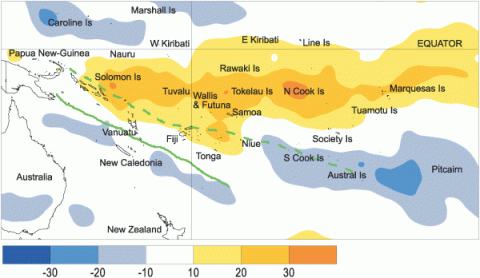Climate developments in March 2005
The outgoing long-wave radiation (OLR) anomaly pattern was very different from that of February. A large region of suppressed convection prevailed in March, extending from the Solomon Islands east to the Marquesas Islands of Northern French Polynesia, including Tuvalu, Wallis and Futuna, Western Samoa, Tokelau, northern Tonga, and the Northern Cook Islands. Rainfall was less than 75% of average in many islands within this region, as well as Vanuatu, southern areas of New Caledonia, and much of Fiji (apart from the east of Viti Levu where it was above average). The South Pacific Convergence Zone (SPCZ) was weaker than normal and was located further south and west than average. Areas of enhanced convection occurred over the Southern Cook Islands, the Austral Islands, and Pitcairn Island. Rainfall was at least 125% of average in parts of Eastern Kiribati.
Mean air temperatures were about 1.0°C above average in Tuvalu, Wallis and Futuna, Northern and Central French Polynesia, at least 0.5°C above average in Fiji and Samoa, near average in Vanuatu and Tonga, and almost 0.5°C below average in New Caledonia.
Tropical Southwest Pacific mean sea-level pressures were above average about and west of the Date Line, being at least 2 hPa above average over New Caledonia. They were near average over Central French Polynesia, and below average over the Southern Cook Islands.
Along the Equator, surface westerlies occurred in 17% of observations at Tarawa. This was a significant decrease from 40% in February, reflecting a return to easterlies.
Climate extremes in March 2005
| Country | Location | Monthly Rainfall (mm) | % of average | Comments |
|---|---|---|---|---|
| Fiji | Udu Point | 84 | 26 | Record low |
| French Polynesia | Tuamotu, Takaroa | 35 | 27 | Record low |
| New Zealand | Kaitaia | 7 | 10 | Record low |
| Country | Location | Daily Rainfall (mm) | Date | Comments |
|---|---|---|---|---|
| Fiji | Vunisea | 251 | 4 March | Record high |

